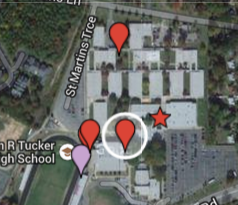Summary
Students are members of the school safety committee. It has come to the committee’s attention that there are not enough wheelchair ramps around campus. The school safety committee will need to investigate the current ramps and make recommendations for new ramps. They will consider federal/state guidelines, recommendations from students/faculty in wheelchairs, and mathematical reasoning. Each collaborative team of students will create a presentation for the school Principal, head of C & M, and school Safety Committee. Throughout this lesson, students will gain a better understanding of what it is like to live with limited mobility as well as learning algebra through real life experiences.
TIPC Ratings
Approaching – The investigation of slope began with students using matchbox style cars and wooden boards to create ramps. They took measurements, timed the cars, and calculated the various slopes using the Pythagorean Theorem.
Using wheelchairs on the ramps outside helped the students to understand why slope is important when constructing a ramp. Is the slope positive or negative? How would you describe your experience? What effect does the slope have on your ability to roll the wheelchair? Does the ramp feel safe or unsafe and why?
In teams of 3-4, the students took measurements and photographs of 2 ramps around campus. They collected data from the wheelchair ramps inside and outside the school buildings. Then they researched federal guidelines using the internet and the ADA. How did our ramps compare with the law? And they had to cite their sources.
There was also a guest speaker from our Faculty who is in a wheelchair. She described situations that were difficult to get from one building to another. And, students asked questions.
Target – While collecting data as a team, students had to decide what roles they would have such as record keeper, measurer, string holder, protractor reader, calculator, etc. Groups of students had to collaborate on the sidewalks without direct supervision. The students entered all data collected from their research outside in a class collaborative Google Spreadsheet.
After a discussion with our guest speaker, students determined a location on campus where there is not a ramp, but they felt there should be one. They used a collaborative Google Map to create a placemark for their ramp location, including a photo, and description of the site. They also researched the cost of materials to build the ramp.
Student findings were documented in a group presentation. Students communicated and collaborated inside the classroom as well as outside the classroom to complete the research, data collection, google map, and presentation.
Students also communicated with a larger audience by making oral presentations to the school Principal and head of C & M. They will each vote on which recommendation will move forward to to the school Safety Committee.
Approaching – The teacher and ITRT will model how to measure the length and height of a ramp using a protractor, when they cannot easily be measured (for example, the ramp is on a hill). Students will use Pythagorean Theorem to calculate the slant height. These students are struggling math students who are mostly ESL; however, all were engaged with the activity.
Students studied the application of the math concept of “slope” to a real-life situation. Using wheelchairs borrowed from the school nurse, students took turns rolling up and down the ramp. After collecting and analyzing data, they decided – where they would put a ramp? Was there a location on campus where there is not a ramp, but they felt there should be one?
Using what they have learned from their previous experiences as well as the federal/state guidelines, they designed a ramp that realistically could solve the problem. They had to think, what other issues do you need to consider besides slope? They also had to justify why that location would need a ramp. This is an open ended problem with many potential solutions.
Approaching
After the matchbox car activity, students made predictions regarding the ramps outside and around campus and their slopes. They had to research, analyze, and synthesize information in order to come up with their solution of where to place a ramp. Sometimes it was difficult for the students because for the slope to adhere to ADA guidelines, using the length and height, the slant height had to be a realistic solution that would fit between the buildings.This was a new solution to an authentic task shared with the school’s safety committee.
Afterwards the students completed a personal reflection of their experience working on the project using a Google Form – here is a link to their responses.





